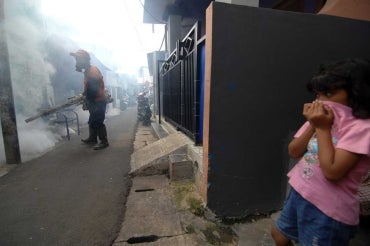Rapid, low-cost detection of Zika virus developed by experts at U of T, Harvard, MIT, Cornell and more

Published: May 5, 2016
It’s a cheap, fast and easy way to detect the Zika virus – using a freeze-dried piece of paper the size of a stamp.
And it was created by the University of Toronto’s Keith Pardee and experts from seven other leading research institutions.
Details of the breakthrough were published in Cell on May 6.
“We hope that, through this work, we have created the template for a tool that can make a positive impact on public health across the globe,” said Pardee, one of the lead authors of the study and an assistant professor at the Leslie Dan Faculty of Pharmacy.
“The diagnostic platform developed by our team has provided a high-performing, low-cost tool that can work in remote locations. We have developed a workflow that combines molecular tools to provide diagnostics that can be read out on a piece of paper no larger than a postage stamp.”
The collaboration included Wyss Institute, Harvard University, Massachusetts Institute of Technology, Boston University, Arizona State University, Cornell University, University of Wisconsin-Madison and the Broad Institute. The team used toehold sensors and isothermal RNA amplification to create the diagnostic sensors. The results: a cell-free, paper-based platform that can host synthetic gene networks for use outside the lab.
It’s a much-needed solution to the challenge of diagnosing the Zika virus, said Pardee (pictured below). 
Right now, reliable diagnosis for patients suspected of the Zika virus involves nucleic acid-based testing. That kind of testing depends on laboratory access, highly specific and expensive equipment and trained technicians – and is unavailable in remote locations where surveillance and containment are critically needed.
This new technology, on the other hand, is easy to use, portable, requires little to no training – and costs less than a dollar per test, Pardee said.
Specifically tuned to the Zika virus, sensors are applied to small paper samples. A saliva, urine, or blood sample – equivalent to the amount required by blood glucose monitors that test blood sugar levels – is applied to the sensors, triggering a response that provides visually evident results in as little as an hour.
If the sample contains the RNA of the Zika virus, the test area turns purple.
Earlier this year, the World Health Organization declared the Zika virus a public health emergency of international concern. While the symptoms experienced by most infected patients of this mosquito-borne illness are mild – fever, rash, joint pain, and conjunctivitis – recent strains of the disease have demonstrated links to fetal microcephaly, birth defects, Guillain-Barré syndrome, and other neurological disorders.
With the onset of nicer weather, this disease is expected to expand to new territories and countries.
“Our synthetic biology pipeline for rapid sensor design and prototyping has tremendous potential for application for the Zika virus and other public health threats, enabling us to rapidly develop new diagnostics when and where they are needed most,” Pardee said.
While this study demonstrates proof-of-concept, the team is eager to secure the necessary partners and resources to proceed to the product development phase, Pardee said. That would be followed up by scaled-up manufacturing and distribution so that the diagnostic tool can be deployed for use in the field.
Ultimately, he added, the development of quick, easy-to-use, in-the-field tests for Zika and similar pathogens could help governments stay ahead of pathogen outbreaks, curbing the spread of disease and lessening the burden on already overtaxed healthcare systems.
“The utility of new low-cost diagnostics that can be deployed to combat public health threats like Zika is tremendous,” said U of T’s Shana Kelley, an expert in rapid diagnostics. “The work of Keith Pardee and his colleagues is a very important step forward as emerging threats appear.”



